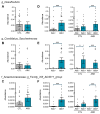The Role of Akkermansia muciniphila on Improving Gut and Metabolic Health Modulation: A Meta-Analysis of Preclinical Mouse Model Studies
- PMID: 39203469
- PMCID: PMC11356609
- DOI: 10.3390/microorganisms12081627
The Role of Akkermansia muciniphila on Improving Gut and Metabolic Health Modulation: A Meta-Analysis of Preclinical Mouse Model Studies
Abstract
Akkermansia muciniphila (A. muciniphila) and its derivatives, including extracellular vesicles (EVs) and outer membrane proteins, are recognized for enhancing intestinal balance and metabolic health. However, the mechanisms of Akkermansia muciniphila's action and its effects on the microbiome are not well understood. In this study, we examined the influence of A. muciniphila and its derivatives on gastrointestinal (GI) and metabolic disorders through a meta-analysis of studies conducted on mouse models. A total of 39 eligible studies were identified through targeted searches on PubMed, Web of Science, Science Direct, and Embase until May 2024. A. muciniphila (alive or heat-killed) and its derivatives positively affected systemic and gut inflammation, liver enzyme level, glycemic response, and lipid profiles. The intervention increased the expression of tight-junction proteins in the gut, improving gut permeability in mouse models of GI and metabolic disorders. Regarding body weight, A. muciniphila and its derivatives prevented weight loss in animals with GI disorders while reducing body weight in mice with metabolic disorders. Sub-group analysis indicated that live bacteria had a more substantial effect on most analyzed biomarkers. Gut microbiome analysis using live A. muciniphila identified a co-occurrence cluster, including Desulfovibrio, Family XIII AD3011 group, and Candidatus Saccharimonas. Thus, enhancing the intestinal abundance of A. muciniphila and its gut microbial clusters may provide more robust health benefits for cardiometabolic, and age-related diseases compared with A. muciniphila alone. The mechanistic insight elucidated here will pave the way for further exploration and potential translational applications in human health.
Keywords: Akkermansia muciniphila; Candidatus Saccharimonas; Desulfovibrio; Family XIII AD3011 group; gut; inflammation; metabolic health.
Conflict of interest statement
The authors declare no conflicts of interest.
Figures








Similar articles
-
The Impact of Akkermansia muciniphila on Mouse Models of Depression, Anxiety, and Stress: A Systematic Review and Meta-Analysis.Curr Neuropharmacol. 2025 Mar 18. doi: 10.2174/011570159X360149250225041829. Online ahead of print. Curr Neuropharmacol. 2025. PMID: 40108902
-
Akkermansia muciniphila: A promising probiotic against inflammation and metabolic disorders.Virulence. 2024 Dec;15(1):2375555. doi: 10.1080/21505594.2024.2375555. Epub 2024 Aug 27. Virulence. 2024. PMID: 39192579 Free PMC article. Review.
-
The Protective Effects of Live and Pasteurized Akkermansia muciniphila and Its Extracellular Vesicles against HFD/CCl4-Induced Liver Injury.Microbiol Spectr. 2021 Oct 31;9(2):e0048421. doi: 10.1128/Spectrum.00484-21. Epub 2021 Sep 22. Microbiol Spectr. 2021. PMID: 34549998 Free PMC article.
-
The Potential Benefits of Akkermansia muciniphila as a Next-Generation Probiotic in the Maintenance of Overall Liver Health.Acta Gastroenterol Belg. 2025 Apr-Jun;88(2):141-150. doi: 10.51821/88.1.13037. Acta Gastroenterol Belg. 2025. PMID: 40504581 Review.
-
Heat-Inactivated Akkermansia muciniphila Improves Gut Permeability but Does Not Prevent Development of Non-Alcoholic Steatohepatitis in Diet-Induced Obese Ldlr-/-.Leiden Mice.Int J Mol Sci. 2022 Feb 19;23(4):2325. doi: 10.3390/ijms23042325. Int J Mol Sci. 2022. PMID: 35216439 Free PMC article.
Cited by
-
Characterizing Gene-Level Adaptations in the Gut Microbiome During Viral Infections: The Role of a Fucoidan-Rich Extract.Genes (Basel). 2025 Jun 26;16(7):740. doi: 10.3390/genes16070740. Genes (Basel). 2025. PMID: 40725397 Free PMC article.
-
Oat Beta-Glucans Modulate the Gut Microbiome, Barrier Function, and Immune Responses in an In Vivo Model of Early-Stage Colorectal Cancer.Int J Mol Sci. 2024 Dec 19;25(24):13586. doi: 10.3390/ijms252413586. Int J Mol Sci. 2024. PMID: 39769349 Free PMC article.
-
Unraveling the gut microbiota's role in obesity: key metabolites, microbial species, and therapeutic insights.J Bacteriol. 2025 May 22;207(5):e0047924. doi: 10.1128/jb.00479-24. Epub 2025 Apr 4. J Bacteriol. 2025. PMID: 40183584 Free PMC article. Review.
-
Intermittent supplementation with Akkermansia muciniphila and galactooligosaccharides modulates Alzheimer's disease progression, gut microbiota, and colon short-chain fatty acid profiles in mice.Front Aging Neurosci. 2025 Jun 30;17:1617980. doi: 10.3389/fnagi.2025.1617980. eCollection 2025. Front Aging Neurosci. 2025. PMID: 40662084 Free PMC article.
-
A computational framework for inferring species dynamics and interactions with applications in microbiota ecology.NPJ Syst Biol Appl. 2025 Aug 5;11(1):87. doi: 10.1038/s41540-025-00568-0. NPJ Syst Biol Appl. 2025. PMID: 40764303 Free PMC article.
References
Publication types
Grants and funding
LinkOut - more resources
Full Text Sources
Molecular Biology Databases

